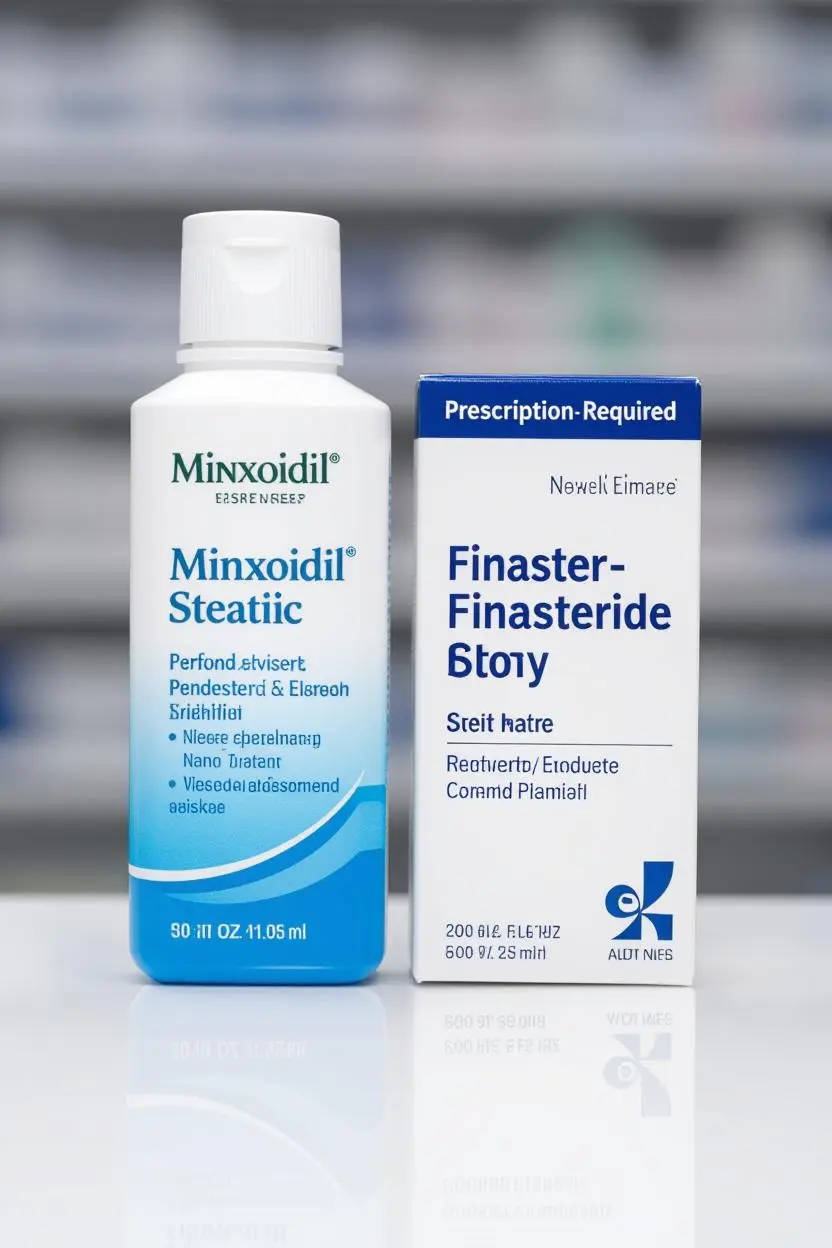One day, you notice it. The clump of hair in the shower drain seems bigger, and the strands on your pillow are suddenly more conspicuous. A wave of anxiety hits you—"Could it be happening to me?"—but you try to push it away. Hair loss is no longer just a concern for middle-aged men. It has become an unwelcome guest that steals confidence from people of all ages and genders. But don't worry. To know your enemy is to win the battle! This article covers everything you need to reclaim a fuller future, from the root causes of hair loss to the most advanced treatments of 2025, and even candid reviews from communities like Reddit. 🧐
1. Why Is My Hair Abandoning Me?: Unpacking the Core Causes of Hair Loss
Hair falls out for a multitude of reasons. Some say, "It's genetic, you can't fight it," while others blame stress. Both are true, but neither tells the whole story. Hair loss is like a symphony, with various factors playing in concert. Let's meet the main culprits.
The Genetic & Hormonal Duo: Androgenetic Alopecia
This is the most common type of hair loss and the primary cause of what's known as "pattern baldness." As the name suggests, it results from an interaction between genetic predisposition and androgens (male hormones). Testosterone, a male hormone, converts into a more potent substance called Dihydrotestosterone (DHT) when it meets an enzyme called 5-alpha reductase. This DHT then attacks the hair follicles of genetically susceptible individuals, causing hair to thin and eventually fall out. Just because your father is bald doesn't mean you're 100% destined for the same fate, but the odds are certainly higher. 👨🦲
Women Aren't Spared: The Nuances of Female Pattern Hair Loss
Hair loss in women presents differently. Instead of a receding M-shaped hairline, women often experience diffuse thinning on the top of the scalp, a pattern sometimes called the "Christmas tree" effect. Major hormonal shifts from childbirth, menopause, or dieting are primary triggers. While DHT also plays a role, the process is far more complex than in men. Underlying conditions like thyroid disease or Polycystic Ovary Syndrome (PCOS) can also be hidden culprits, making a nuanced approach crucial for female hair loss.
Sudden Shedding? Telogen Effluvium
If you've experienced a sudden, significant shedding of hair 2-3 months after a period of intense stress, major surgery, or rapid weight loss, you might be dealing with Telogen Effluvium. Our hair cycles through growing, resting, and shedding phases. When the body undergoes a major shock, a large number of hairs can prematurely enter the "shedding" (telogen) phase all at once. The good news is that it's usually temporary and resolves within six months to a year once the trigger is gone. However, chronic stress can lead to chronic Telogen Effluvium, so be mindful.
An Immune System Misfire: Alopecia Areata
If you suddenly find a coin-sized patch of complete hair loss, it's likely alopecia areata. This is a type of autoimmune disease where the body's immune system mistakenly attacks its own hair follicles. Stress is a well-known trigger. While it can sometimes resolve on its own, it can also appear in multiple spots or, in severe cases, lead to total scalp hair loss (alopecia totalis).
"In the words of Reddit user 'balding_throwaway_23' from the r/tressless subreddit: 'Seeing my scalp at 25 felt like the end of the world. But I found hope again after understanding the cause and starting medication. The most important things are starting early and staying consistent.'"
2. The Never-Ending Battle: The A-to-Z of Hair Loss Treatment
Now that we know the enemy, it's time to fight back. Modern medicine has armed us with some powerful weapons. Let's explore the most proven and widely used methods.

The Topical Shield: Minoxidil
Originally developed as a blood pressure medication, Minoxidil's hair-growing side effect was a serendipitous discovery. It works by widening blood vessels in the scalp, allowing more oxygen and nutrients to reach the hair follicles. It's suitable for both men and women and is available over-the-counter. Typically used in 3-5% concentrations, consistent twice-daily application is key. You might experience an initial "shedding phase" where more hair falls out, but don't panic! This is a positive sign that the medication is working.
The Oral Spear: Finasteride & Dutasteride
These drugs directly inhibit the 5-alpha reductase enzyme responsible for creating the hair-loss villain, DHT. Finasteride (brand name Propecia) and Dutasteride (brand name Avodart) are highly effective, especially for male pattern baldness. However, they are prescription-only medications. They are not safe for women of childbearing age to take or even handle, as they can cause birth defects. While some users report side effects like sexual dysfunction or "brain fog," the incidence is low, and symptoms typically resolve after discontinuation.
Key Takeaway: The Sooner, The Better!
All hair loss treatments are most effective when the hair follicles are still alive. Once a follicle is completely gone, medication alone cannot regrow hair. If you suspect you're losing hair, don't hesitate. Consult a specialist to seize the golden window of opportunity.
The Ultimate Solution: Hair Transplantation
For those who haven't seen results with medication or whose hair loss is advanced, a hair transplant is the most definitive option. This surgical procedure involves moving hair follicles from DHT-resistant areas (like the back and sides of the head) to the balding areas. The transplanted hair is largely permanent. However, it's a costly procedure, and you'll likely need to continue medication to maintain the non-transplanted hair.
3. No More Snake Oil: Community-Vetted Tips and Tricks
Lifestyle management is just as crucial as medical treatment. Online communities like Reddit's r/tressless are treasure troves of hard-won wisdom from "hair loss veterans." Here are some of the most frequently shared tips.
- Your Shampoo Isn't the Problem: Claims that a "hair loss shampoo" can regrow hair are mostly marketing fluff. A shampoo's primary job is to clean your scalp. By removing dirt, oil, and dead skin cells, you create a healthy environment for hair to grow. Instead of investing in expensive shampoos, focus on finding a product suited to your scalp type (oily/dry) and washing your hair thoroughly in the evening.
- The Deal with Supplements: Nutrients like biotin, zinc, and iron are essential for healthy hair. However, unless you have a specific deficiency, supplements alone won't produce dramatic results. It's wiser to view them as "adjuvants" to your primary medical treatment. They can be particularly helpful for women experiencing nutritional imbalances from frequent dieting.
- Scalp Massage and Circulation: Gently massaging your scalp with your fingertips can improve blood flow, helping to deliver more nutrients to your follicles. But be gentle! Scratching with your nails or applying excessive pressure can damage the scalp and do more harm than good.
4. A Glimmer of Hope: The New Horizon of Hair Loss Treatment in 2025
Tired of the daily pill or topical application? Worried about side effects? Fortunately, science never sleeps. As of 2025, several innovative technologies are emerging that could change the paradigm of hair loss treatment.
Harnessing Your Own Blood: PRP Therapy
Platelet-Rich Plasma (PRP) therapy involves drawing your own blood, concentrating the platelets in a centrifuge, and injecting this "liquid gold" back into your scalp. The growth factors abundant in platelets activate hair follicle stem cells and promote hair growth. It's known to have a synergistic effect when combined with medication and has the major advantage of being virtually side-effect-free.
The Rise of Stem Cells and Exosomes
The darlings of regenerative medicine, stem cells, are now in the spotlight for hair loss. Treatments involve extracting stem cells from hair follicles, cultivating them, and reinjecting them, or using "exosomes," the key signaling molecules secreted by stem cells. Exosomes work by improving the microenvironment around the follicle, reducing inflammation, and promoting regeneration. While more research is needed, this field holds immense potential to be a game-changer.
JAK Inhibitors: A New Hope for Alopecia Areata
Recently FDA-approved drugs like Olumiant and Litfulo, known as JAK inhibitors, have brought a breakthrough for treating alopecia areata, an autoimmune disorder. They work by blocking the immune signals that cause the body to attack its own hair follicles, leading to remarkable regrowth. While not yet applicable to androgenetic alopecia, this is a beacon of hope for those suffering from immune-related hair loss.
Conclusion: Your Follicles Haven't Given Up Yet
Hair loss is more than just a physical change; it can cause profound psychological distress. But by reading this article, you've already taken the first step toward change. The keys are to act fast with accurate information and manage it consistently. Instead of wasting time and money on unproven folk remedies, the wisest move is to consult a dermatologist and create a scientific treatment plan tailored to you. Your efforts will not betray your hair. Don't give up—a fuller future is within reach! 💪
